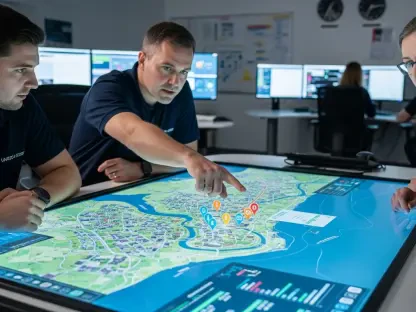Ambient computing, a concept born from the visionary ideas of Mark Weiser more than three decades ago, is finally making its way into the mainstream. This seamless integration of computing into everyday life is becoming more apparent thanks to the combination of Artificial Intelligence (AI) and Augmented Reality (AR). These technologies are poised to transform how we interact with our environments, creating a world where technology is invisibly pervasive. With ambient computing, the aim is to make the interactions between humans and technology seamless, intuitive, and virtually invisible. By discreetly operating in the background, ambient computing promises to make everyday experiences more efficient and enjoyable, reshaping our physical spaces in groundbreaking ways.
Ambient computing is an ambitious paradigm where various connected devices operate unobtrusively in the background to enhance everyday experiences. The goal is to dissolve the boundaries between technology and humans, making interactions natural and intuitive. From smart homes and workplaces to automotive innovations, ambient computing is gradually reshaping our physical spaces in groundbreaking ways. This model of computing envisions an environment where technology is so well-integrated that its presence goes unnoticed, thus offering a more natural way of living and working.
The Genesis of Ambient Computing
Ambient computing originated from Mark Weiser’s vision in 1991. He foresaw a world where intelligent interconnected devices work seamlessly in the background, making technology virtually invisible. Weiser’s classic example involved an alarm clock communicating with a coffee maker to brew coffee as soon as the user woke up—an everyday action automated to perfection. This vision laid the foundation for what would become a broad field aimed at simplifying user interactions with technology by embedding intelligence and connectivity into everyday objects and environments.
Over the past decades, we have seen incremental steps toward this vision. The advent of IoT (Internet of Things) has played a crucial role, linking millions of sensor-based devices. These interconnected devices laid the groundwork for creating ambient environments where technology flows seamlessly and discreetly. IoT technology made it possible to integrate different devices and systems into a cohesive network, thus enabling a level of automation and intelligence that was previously unimaginable.
Various technological milestones have contributed to the evolution of ambient computing. For instance, the development of low-power sensors and advances in connectivity standards have made it feasible to deploy large-scale networks of interconnected devices. These devices can communicate with each other and respond to environmental changes in real-time, thereby enhancing the user experience. The seamless interaction between devices is a critical aspect of ambient computing, ensuring that the technology works in the background with minimal manual intervention.
Early Implementations and Real-World Examples
Various technologies have embodied the principles of ambient computing over the years. Smart thermostats that adjust according to occupancy, lighting systems engaged with security systems, and workplace automation all serve as nascent examples. These initial applications demonstrated how ambient computing could streamline operations, enhance efficiency, and elevate user experiences. These systems are designed to be intuitive and responsive, reducing the need for manual control while adapting to user preferences in real-time.
In workplaces, automated meeting setups, adaptive lighting, and voice-activated assistants exemplify how ambient computing can transform professional environments. These systems anticipate user needs and create responsive environments that adapt naturally, minimizing manual intervention and optimizing convenience. Automated meeting setups, for example, can configure room settings, manage video conferencing equipment, and even adjust lighting and temperature to suit the needs of the participants. This kind of automation simplifies workflow, allowing professionals to focus on their tasks rather than managing the technology.
Another compelling example is the integration of voice-activated assistants into the workplace. These assistants can handle a variety of tasks, from scheduling meetings to controlling environmental settings, thereby reducing the cognitive load on employees. Adaptive lighting systems can adjust brightness and color temperature based on the time of day and activity, promoting better focus and well-being. These implementations serve as early indicators of how ambient computing can improve productivity and create more pleasant working conditions.
Rise of Smart Homes and Everyday Comfort
The proliferation of smart home devices further underscores the growing influence of ambient computing. Products like smart speakers, intelligent thermostats, and security cameras integrate seamlessly, ensuring users can control their environments with minimal effort. Voice assistants such as Amazon’s Echo have popularized these interactions, turning voice commands into the primary interface for managing various home systems. These devices not only make life more convenient but also provide a glimpse into the future of ambient computing.
Through these interconnected systems, homes can learn user preferences and adjust settings accordingly, paving the way for an intuitive living experience. For example, lights automatically adjust based on the time of day, and security systems can arm themselves when the last person leaves the house. These advancements exemplify Weiser’s vision of making technology ‘invisible’ by integrating it effortlessly into our daily routines. Smart home systems can sense user behavior and anticipate needs, offering a level of convenience that was once the stuff of science fiction.
Additionally, the integration of machine learning algorithms enables these systems to become increasingly adept at predicting user needs. Over time, the smart home becomes more attuned to the habits and preferences of its occupants, making automatic adjustments that enhance comfort and efficiency. For instance, a smart thermostat can learn a household’s schedule and adjust temperatures accordingly to optimize energy savings while maintaining comfort. Similarly, smart lighting can adjust brightness levels based on natural light availability and user activity. These examples illustrate the practical benefits of ambient computing in creating a more responsive and efficient living environment.
The Automotive Industry: A New Frontier
The automotive industry has emerged as a fertile ground for ambient computing innovations. Modern vehicles are increasingly equipped with smart sensors, voice assistants, and adaptive systems, creating an ambient ecosystem within the car. These technologies enhance the driving experience by providing real-time data and predictive features without overwhelming the driver. This integration of ambient computing aims to make driving safer, more comfortable, and more enjoyable.
For instance, voice-activated navigation, automatic climate control, and adaptive cruise control are all becoming standard features in new vehicles. These ambient systems ensure that the driving environment responds dynamically to the user’s interactions, enhancing safety and comfort while minimizing active management. Voice-activated navigation allows drivers to keep their eyes on the road while interacting with their navigation system, thus improving safety. Automatic climate control systems adjust temperature and airflow based on real-time conditions and user preferences, ensuring optimal comfort.
Another notable development is the incorporation of advanced driver assistance systems (ADAS) that utilize ambient computing principles. These systems can monitor the vehicle’s surroundings and provide real-time feedback to the driver, helping to prevent accidents and improve overall safety. Features such as lane-keeping assistance, automatic emergency braking, and adaptive headlights exemplify how ambient computing can make driving safer and more intuitive. By leveraging the power of AI and sensor technology, these systems can predict and respond to potential hazards, offering a higher level of safety and convenience.
Challenges and Opportunities in Form Factors
Despite the promising developments, widespread adoption of ambient computing has faced several challenges, particularly concerning form factors. The correct form factor is critical for user acceptance. Products like the Humane pin, which aimed to provide ambient computing experiences as wearable devices, often missed their mark because they deviated from familiar and accepted forms like glasses or traditional wearables. The importance of form factor cannot be overstated; if a device is not comfortable or convenient to use, it will struggle to find acceptance, regardless of its technological capabilities.
Another challenge is maintaining user interest. Major tech companies like Google have at times shifted their focus away from ambient computing initiatives, revealing the volatile nature of market trends. Successfully integrating ambient computing requires not only technical innovation but also aligning product design with user expectations and practical utility. Companies need to understand the needs and preferences of their target audiences to create products that are not only innovative but also practical and user-friendly.
The industry must also address privacy and security concerns associated with ambient computing. As these systems become more integrated into our daily lives, the amount of personal data they collect will increase, raising potential privacy issues. Ensuring robust security measures and transparent data policies will be essential for gaining user trust and ensuring widespread adoption. Addressing these concerns involves not only implementing advanced encryption and security protocols but also educating users about how their data is being used and stored.
AI and AR: The Ultimate Enablers
The convergence of AI and AR technologies is being hailed as the definitive catalyst for achieving fully realized ambient computing. AR’s potential to overlay digital information onto the physical world, combined with AI’s ability to predict and fulfill user needs, propels us closer to a seamless, interactive environment. Together, these technologies offer the promise of creating environments that are both intelligent and responsive, enhancing the way we interact with the world around us.
Devices like the Apple Vision Pro highlight the immense possibilities. These AR devices can transform the way users interact with digital information, making it as natural as glancing at their surroundings. Simple gestures and contextual AI predictions take the interaction experience to unprecedented levels of intuitiveness. By leveraging the capabilities of AR and AI, these devices make it possible to seamlessly blend digital content with the physical world, creating a unified experience that feels both natural and immersive.
AI plays a crucial role in understanding user behavior and making context-aware predictions. Machine learning algorithms can analyze vast amounts of data to identify patterns and anticipate user needs. When integrated with AR, AI can provide real-time information and insights based on the user’s context, making interactions more relevant and valuable. For example, AR glasses equipped with AI can provide real-time translations, navigation assistance, or contextual information about the user’s surroundings, enhancing everyday experiences and making them more intuitive.
Revolutionizing Human-Environment Interaction
Over the years, various technologies have embodied the principles of ambient computing. Smart thermostats that adjust automatically based on occupancy, lighting systems integrated with security systems, and workplace automation are initial examples. These applications showed how ambient computing could streamline operations, improve efficiency, and enhance user experiences. Designed to be intuitive and responsive, these systems minimize the need for manual control while adapting to user preferences in real-time.
In professional settings, ambient computing manifests in automated meeting setups, adaptive lighting, and voice-activated assistants. These technologies predict user needs and create responsive environments, reducing manual intervention and maximizing convenience. For instance, automated meeting setups can configure room settings, manage video conferencing equipment, and adjust lighting and temperature to meet participant preferences. This automation simplifies workflows, enabling professionals to concentrate on their tasks rather than managing the technology.
Voice-activated assistants are another notable example, handling diverse tasks from scheduling meetings to controlling environmental settings, thereby reducing employees’ cognitive load. Adaptive lighting systems can modify brightness and color temperature based on time and activity, promoting better focus and well-being. These early implementations showcase how ambient computing can boost productivity and create more enjoyable work environments.









